by Mary Hrovat
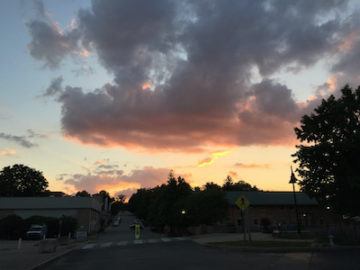 This summer I noticed that I was sharing a lot of sunset photos on social media. I don’t think of myself as a photographer, and I’m much more likely to share words than images. When I thought about it, I realized this wasn’t a sudden change. I’ve been taking the odd set of sunset pictures with my Canon every now and then, and I’ve noticed that my eyes are increasingly drawn to the sky and the light when I look at landscape photos.
This summer I noticed that I was sharing a lot of sunset photos on social media. I don’t think of myself as a photographer, and I’m much more likely to share words than images. When I thought about it, I realized this wasn’t a sudden change. I’ve been taking the odd set of sunset pictures with my Canon every now and then, and I’ve noticed that my eyes are increasingly drawn to the sky and the light when I look at landscape photos.
And I’ve always loved the sky. It holds so many fascinating things: light, color, clouds, weather. Trees, birds. Moon, planets, stars. Time itself, and change. I like to walk at twilight, when the world is shifting from day to night, so it’s natural that sunsets would become a focus. This spring a friend gave me an old iPhone to use as a camera; it’s easy to carry with me, so I’ve been taking more pictures.
But I can’t really understand why I’m so utterly captivated by the colors of the sky, and their subtle gradations and changes. I feel as if I can never spend too much time just looking, at the sky and at other people’s images of it, and at plants, birds, bugs… . When I try to describe the strong desire to soak up as many experiences of nature as I can, to sense the colors and shapes as deeply as I can, I feel like I’m trying to explain a cannabis-induced insight: Everything is so beautiful! It feels kind of like craving, but not in an itchy unsatisfied way. In her poem “Born Into a World Knowing,” Susan Griffin wrote about hoping for a gentle death, “perhaps in someone’s arms, perhaps tasting chocolate…or saying not yet. Not yet the sky has at this moment turned another shade of blue.” There is always another shade of blue.
∞
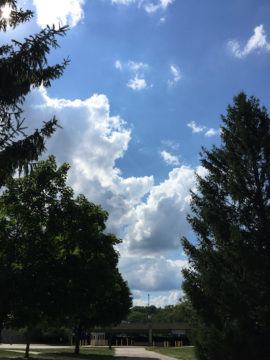 Inevitably, I started photographing the sky at other times of day. I was out walking a few weeks ago, one of those summer afternoons where the sky is a shifting panorama of towering cumulus clouds, and I took some daytime photos. I went on from there, and at some point I decided that as a game, or a practice, I’d post a photo of the sky on social media every day.
Inevitably, I started photographing the sky at other times of day. I was out walking a few weeks ago, one of those summer afternoons where the sky is a shifting panorama of towering cumulus clouds, and I took some daytime photos. I went on from there, and at some point I decided that as a game, or a practice, I’d post a photo of the sky on social media every day.
I take a fair number of pictures each day; for this project, I select one to post. That’s part of the game, a limit and a guide: just one. The choice is based partly on the quality of the photo, and how representative and/or visually appealing I think it is. But variety may be the most important criterion. I try to post things that are different from anything I posted before.
One morning, maybe a week into this project, I woke to a flat white overcast sky. “Aha,” I thought. “This is where it gets interesting.” I’ve been photographing lots of gloriously sunlit cumulus clouds, but I knew there would be days of hazy summer skies of buttermilk blue with no distinguishing features, or gray winter skies, or, even in Indiana, periods of cloudless skies of no particular distinction. Part of the game is to represent the sky as it is each day rather than aim for a particular type of picture. I thought the non-dramatic days would be interesting challenges.
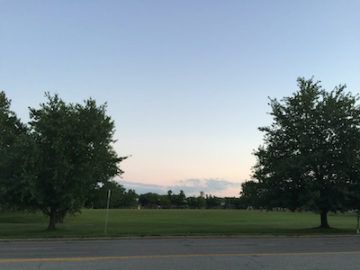 I’m also sure that the more I look at the sky, the more I’ll see. Nature opens up if you give it time and space. As it happened, that overcast morning turned into a variable day, with plenty of clouds forming and dissipating. But I’m interested in seeing how this project develops as I photograph more skies, even (or especially) the ones that seem plain at first.
I’m also sure that the more I look at the sky, the more I’ll see. Nature opens up if you give it time and space. As it happened, that overcast morning turned into a variable day, with plenty of clouds forming and dissipating. But I’m interested in seeing how this project develops as I photograph more skies, even (or especially) the ones that seem plain at first.
Within the limit of posting one photo per day, there are so many possibilities. I’ve started to pair words and images, for example, which opens up many avenues. I think it might be fun to do a series where I simply go outside at a set time each day, face in a certain direction, and take a photo. This practice feels very open.
∞
One evening a few years ago when I was out walking, I stopped to watch a sunset. I had met that day’s deadline and didn’t need to start toward the next day’s, so I had time to watch the whole thing: the first hints of subtle color and the flare of brilliant reds and oranges. I stayed on until the reds had faded to dusty rose and then slipped away and the sky was turning to twilight, the shadow of Earth well risen in the east. I remember thinking that this is one of the most important things: having the flexibility to give the natural world the prolonged attention that it rewards so abundantly.
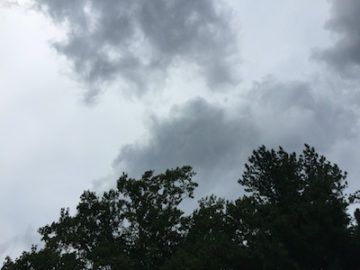 My increasing desire to watch time passing in a changing sky (forest, meadow, beach…) is partly an effect of growing older. I’ve been slowly coming to terms with the losses that accumulate with time; although they’re still painful, somehow the weight of the future has lifted even as horizons have narrowed. I feel freer. It’s also about being in a pandemic and watching climate change end the world we knew. A lot of the things I thought I wanted or should work toward seem inaccessible and even beside the point. It’s easier to simply love what’s in front of me.
My increasing desire to watch time passing in a changing sky (forest, meadow, beach…) is partly an effect of growing older. I’ve been slowly coming to terms with the losses that accumulate with time; although they’re still painful, somehow the weight of the future has lifted even as horizons have narrowed. I feel freer. It’s also about being in a pandemic and watching climate change end the world we knew. A lot of the things I thought I wanted or should work toward seem inaccessible and even beside the point. It’s easier to simply love what’s in front of me.
I said to a friend recently that I’ve become obsessed with sunsets. But for an obsession, it’s remarkably harmless. The sky will never break my heart or abandon me. You can’t buy or sell sunsets or clouds, hoard them or collect the whole set. You don’t need to store them or worry that they’ll be stolen. If my hard drives all crash and I lose every photo, I’ll be upset, but I’ll still have the important thing, which is the experience. In fact, the concept of obsession doesn’t really fit. I’ve been thinking about others: fascination, absorption, enchantment. Love.
∞
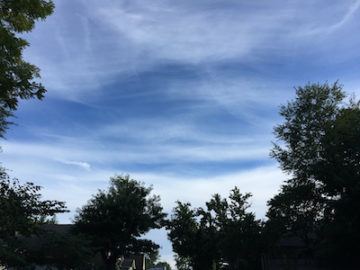 One thing I’ve become keenly aware of since I started posting daily photos is how quickly the sky changes. You can’t postpone your enjoyment or your efforts to capture it; you can’t accumulate sunsets or clouds or shades of blue to look at later. They’re in the moment. It used to make me anxious to realize how transitory this kind of beauty is. For some reason the fear of missing out has subsided as I realize that I’m always missing out (I’m a finite creature, after all), but that means there will always be something new to see. There is enough.
One thing I’ve become keenly aware of since I started posting daily photos is how quickly the sky changes. You can’t postpone your enjoyment or your efforts to capture it; you can’t accumulate sunsets or clouds or shades of blue to look at later. They’re in the moment. It used to make me anxious to realize how transitory this kind of beauty is. For some reason the fear of missing out has subsided as I realize that I’m always missing out (I’m a finite creature, after all), but that means there will always be something new to see. There is enough.
Another thing I’ve been increasingly aware of is the balance between experiencing and capturing. Sometimes I look out at the sky, or go outside and watch for a while, without taking a picture—because my time is limited, but also because paying attention is enough. I don’t need or want to interrupt my experience by funneling it through the camera.
I went out early on a recent morning to look at the crescent moon in the pre-dawn sky. The morning was cool and quiet and so beautiful. Over my right shoulder, Jupiter shone brightly as I faced east, toward the moon and the rising winter stars. Orion’s belt had just cleared the trees and houses across the street. Above Betelgeuse, which marks one of his shoulders, two other orange lights, Aldebaran and Mars, made a nearly straight line, with the Pleiades slightly west and north of Mars. This was enough—any one of these things would have been enough—to make it well worthwhile to stand outside for a bit.
And then I started to see ghostly clouds skimming across the sky. They seemed gauzy; Mars and the stars came and went, but Jupiter and the moon were never fully obscured. I think those clouds must have been very low to be moving so rapidly. I was amazed and delighted; the motion of clouds is typically stately and slow, whereas these were like dried leaves racing across a sidewalk on a windy day. And they came in wave after wave; for some reason I imagined horses sailing by at full gallop, especially as I watched them receding to the south. I stayed out for half an hour, and the clouds were still moving by when I went in. It wasn’t the kind of experience you could hope to plan for or record. You had to be there.
I’m sure the sky does wondrous things like that all the time. One night, decades ago, I was out around midnight watching a lunar eclipse when I was startled by several geese. At least I concluded they must have been geese—dim shapes flying low, moving swiftly northward. It’s always a little magical to see a skein of geese in the sky, but seeing just a few of them under those circumstances was eerie and lovely. I can’t predict these ordinary wonders, but sometimes I can be there for them.
∞
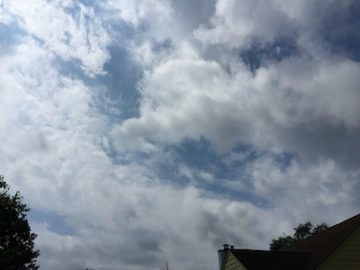 Every day I’m learning about taking pictures, about clouds and the daily patterns of the sky. I’m also realizing how much can’t be captured, and I’m aware that anything I share—pictures I take or words I write—can’t really convey the experience, the fleetingness of it, the richness, all of the sensory aspects. But I want to do it anyway, and to see the images and read the words that other people share.
Every day I’m learning about taking pictures, about clouds and the daily patterns of the sky. I’m also realizing how much can’t be captured, and I’m aware that anything I share—pictures I take or words I write—can’t really convey the experience, the fleetingness of it, the richness, all of the sensory aspects. But I want to do it anyway, and to see the images and read the words that other people share.
Annie Dillard, in For the Time Being, mentioned many recorded observations of clouds, made by John Muir, John Constable, Gerard Manley Hopkins, and others. She asked: “Why seek dated clouds? Why save a letter, take a snapshot, write a memoir, carve a tombstone?” Clark Strand put it another way. In Seeds from a Birch Tree: Writing Haiku and the Spiritual Journey, he wrote: “Certain poems require no explanation. They stand for what they are. On a summer afternoon the newspaper taken out of a grocery bag feels cool. If that is not meaningful, then much of life must not be meaningful as well. The task of the haiku poet is not to explain such moments, but to live them, and to capture their life in words.” We keep trying to do that, knowing the words and images are ultimately just as ephemeral as the thing they are trying to capture. We’re like crows, picking up shiny things and letting them go, or children, building sand castles and knowing they will be washed away.
A quote from Slaughterhouse-Five has also been coming to mind recently. Kurt Vonnegut wrote: ”And I asked myself about the present: how wide it was, how deep it was, how much was mine to keep.” The sky, like the present, is infinitely wide and infinitely deep. None of it is mine to keep.
∞
All of the photographs are my work.
You can see more of my writing at MaryHrovat.com.
